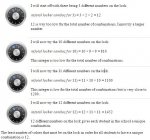There are 1200 students at a school. Each student has a locker. A lock combination uses three numbers, such that consecutive numbers must be different. What is the least number of values that must be on the lock in order for all students to have a unique combination?
I understand that the answer would be along the lines of...
P(least # of locker combos)=(12!)+(11!)+(11!)
=558835200
But I need more explanation as to why this is? It's sort of confusing to me
I understand that the answer would be along the lines of...
P(least # of locker combos)=(12!)+(11!)+(11!)
=558835200
But I need more explanation as to why this is? It's sort of confusing to me
Last edited:

